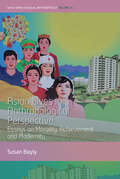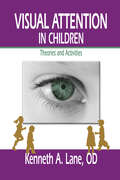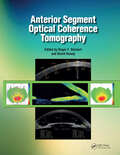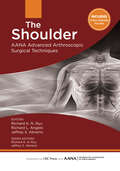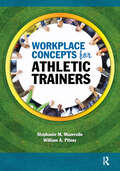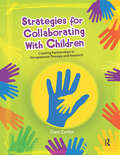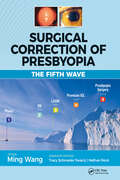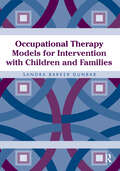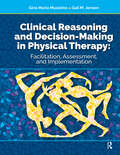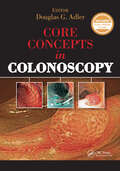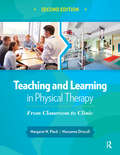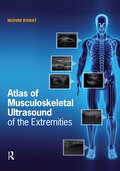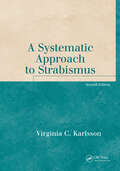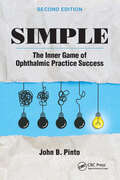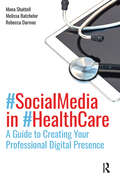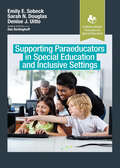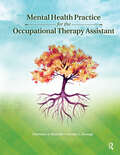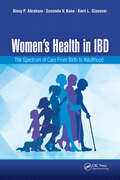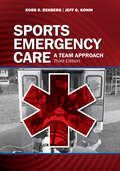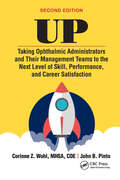- Table View
- List View
Asian Lives in Anthropological Perspective: Essays on Morality, Achievement and Modernity (WYSE Series in Social Anthropology #16)
by Susan BaylyContemporary Asian societies bear the imprint of the experience and afterlives of colonialism, revolutionary socialism and religious and secular nationalism in dramatically contrasting ways. Asian Lives in Anthropological Perspective draws together essays that demonstrate the role of these far-reaching transformations in the shaping of two Asian settings in particular – India and Vietnam. It traces historical and contemporary realities through a variety of compelling topics including the lived experience of India’s caste system and the ethical challenges faced by Vietnamese working women.
Visual Attention in Children: Theories and Activities
by Kenneth LaneIn typical child development, attention controls many aspects of learning, including memory, motor control, and problem solving. Attention organizes the constant influx of information that needs to be absorbed by children. Inside Visual Attention in Children: Theories and Activities, Dr. Kenneth A. Lane describes the positive aspects of attention that are needed for children to be successful in the classroom, such as concentration and vigilance, as opposed to negative aspects that can lead to failure, such as distractibility and confusion. This book is divided into two parts. The first eight chapters of the book explain attention and its relationship to vision and visual stimuli. The core topics discussed here include Autism, ADHD, Dyslexia, Executive Function, and Memory. The second half outlines a Vision Therapy program and consists of activities for improving visual attention in children. Over 100 activities are explained and illustrated.Visual Attention in Children: Theories and Activities is anchored on current theories in five areas of attention that shape child development.Theories Described Include:• Focused Attention – The ability to respond discreetly to visual, auditory, and tactile stimuli• Selective Attention – The ability to maintain behavioral or cognitive abilities in the face of distracting or competing stimuli• Shifting Attention – The ability to rapidly shift attention from one object to another• Sustained Attention – The ability to maintain a consistent behavioral response during a continuous or repetitive activity• Divided Attention –The ability to engage in more than one attention-focused task at one time.Visual Attention in Children: Theories and Activities is the perfect tool for occupational therapy students and clinicians as well as other professionals specializing in child development and learning who are looking to enhance their understanding of this topic and who need unique ideas and activities to add to their visual therapy training programs.
Anterior Segment Optical Coherence Tomography
by David Huang Roger SteinertHigh-speed anterior segment optical coherence tomography (OCT) offers a non-contact method for high resolution cross-sectional and three-dimensional imaging of the cornea and the anterior segment of the eye. As the first text completely devoted to this topic, Anterior Segment Optical Coherence Tomography comprehensively explains both the scientific principles and the clinical applications of this exciting and advancing technology.Anterior Segment Optical Coherence Tomography enhances surgical planning and postoperative care for a variety of anterior segment applications by expertly explaining how abnormalities in the anterior chamber angle, cornea, iris, and lens can be identified and evaluated using the Visante OCT™.Inside Anterior Segment Optical Coherence Tomography, Dr. Roger Steinert and Dr. David Huang, along with 22 of the field's leading professionals, provide a wealth of useful clinical and physiological material about this new diagnostic imaging technique. Valuable images are included to assist in the pre- and postoperative assessment of various anterior segment disorders. Additionally, this unique resource contains detailed information on biometric measurements to enhance diagnostic capability.On the leading edge of anterior segment imaging: Mapping of corneal thickness and keratoconus evaluation Measurement of LASIK flap and stromal bed thickness Visualization and measurement of anterior chamber angle and diagnosis of narrow angle glaucoma Measuring the dimensions of the anterior chamber and assessing the fit of intraocular lens implants Visualizing and measuring the results of corneal implants and lamellar procedures Imaging through corneal opacity to see internal eye structures With the increase in popularity of anterior chamber imaging, and anterior segment OCT proving to be the best tool for high resolution biometry, Anterior Segment Optical Coherence Tomography is a must-have for anterior segment, refractive, cornea, and glaucoma surgeons.
The Shoulder: AANA Advanced Arthroscopic Surgical Techniques (AANA Advanced Arthroscopic Techniques series)
by Jeffrey Abrams Richard Ryu Richard AngeloCo-published with the Arthroscopy Association of North America, The Shoulder: AANA Advanced Arthroscopic Surgical Techniques is a comprehensive technique-based book that presents the latest diagnostic and reconstructive techniques in arthroscopic surgery for the shoulder.The Shoulder: AANA Advanced Arthroscopic Surgical Techniques is authored by premier arthroscopic surgeons Drs. Richard K.N. Ryu, Richard L. Angelo, and Jeffrey S. Abrams, and their international list of expert contributors. This comprehensive resource includes preferred physical examination testing and diagnostic imaging choices in pre-operative planning and patient selection, state-of-the-art step-by-step description of the procedures, detailed surgical equipment lists to perform each procedure, clear and precise indications for surgery and the thoughtful rationale behind stated contraindications, controversial indications, post-operative protocols, and potential complications.The written text is supported by numerous color images and a website with invaluable, narrated video clips depicting disease-specific arthroscopic techniques specific to the shoulder.Features inside The Shoulder: AANA Advanced Arthroscopic Surgical Techniques Narrated video accompanies all surgical techniques, focusing on the stepwise approach to each operation Consistent organization throughout the book results in a bulleted and user-friendly interface for a quick reference or prolonged study Top 5 Technical Pearls for each procedure to enhance outcomes and to avoid common pitfalls and complications High-quality artwork and figures to complement clinical images Equipment and surgical technique checklists for quick reference prior to surgery Each expert contributor was chosen for his or her expertise for a specific topic related to The Shoulder, so the reader benefits by the highest quality and treatment recommendations to provide state-of-the-art care to his or her patient.Some chapter topics include: Arthroscopic Latarjet Stabilization Arthroscopic A-cromioclavicular Joint Reconstruction Arthroscopic Subscapularis Repair: The Extra-Articular Technique Arthroscopic Suprascapular Nerve Release Arthroscopic Suprapectoral Biceps Tenodesis
Workplace Concepts for Athletic Trainers
by William Pitney Stephanie MazerolleAthletic trainers often find themselves immersed in organizations that can critically influence the way in which they fulfill their professional obligations. The workplace can offer many situations that are challenging, particularly for those athletic trainers who are transitioning into clinical practice.With that in mind, Workplace Concepts for Athletic Trainers provides readers with clear and meaningful information that addresses common concepts and issues that occur in the workplace. The topics selected are a reflection of those covered in the literature as problematic yet identifiable and manageable. Each chapter begins with learning objectives and includes a discussion of the issue itself, how it manifests (sources and antecedents), and strategies and solutions to address the concern.Inside Workplace Concepts for Athletic Trainers, Drs. Stephanie M. Mazerolle and William A. Pitney have infused each chapter with case studies to help readers apply the information presented. The conclusion of each chapter contains a summary, questions for review, and suggested readings to reinforce learning. The recommendations and information presented are designed to improve the workplace culture and climate and provide readers with practical suggestions for dealing with workplace issues.Included with the text are online supplemental materials for faculty use in the classroom.Workplace Concepts for Athletic Trainers is a must-have for any athletic training student transitioning into clinical practice or a clinician seeking help for common issues that occur in the workplace.
Strategies for Collaborating With Children: Creating Partnerships in Occupational Therapy and Research
by Clare CurtinStrategies for Collaborating With Children: Creating Partnerships in Occupational Therapy and Research applies client-centered and strengths-based theories to pediatric practice. The text is organized using a research-based conceptual model of collaboration. Within this text, there are detailed descriptions of how to engage and work with children aged 3 to 12 years, from the beginning to the end of therapy.Dr. Clare Curtin covers a variety of topics, such as how to interview children, involve them in defining the purpose of therapy, and develop self-advocacy. Similarly presented is the therapist’s role as a guide in setting respectful limits, teaching self-regulation, avoiding power struggles, and co-creating educational experiences that are challenging and fun. Strategies for Collaborating With Children: Creating Partnerships in Occupational Therapy and Research advocates for children's rights and participation in therapy and research. The United Nations Convention on the Rights of the Child, the new sociology of childhood, and childhood studies are discussed. Also included are children's perspectives on what therapists should know and what children said they might be thinking at each stage of therapy. The last chapter focuses on methods to enhance children’s participation in research, including adaptations for children with disabilities.Unique features: Describes a new research-based model of collaboration with children Incorporates children’s views and knowledge about therapy Illustrates the use of client-centered and strengths-based theories as well as child-friendly approaches within pediatric practice Provides over 1,600 practical strategies that are exemplified by stories with actual dialogue Describes ways to involve children throughout the research process Identifies verbal, visual, and activity-based participatory research methods for eliciting children's voices, including creative ways to involve children with different levels of abilities Includes review questions at the end of each chapter Included with the text are online supplemental materials for faculty use in the classroom.Strategies for Collaborating With Children: Creating Partnerships in Occupational Therapy and Research delivers a comprehensive resource for collaborating with children for the occupational therapist, occupational therapy assistant, or any other practitioner working with children in a therapeutic setting.
Surgical Correction of Presbyopia: The Fifth Wave
by Ming WangUntil recently, surgical correction of presbyopia was considered the “last frontier” in ophthalmology, but today there are a wide variety of treatments available. This Fifth Wave of ophthalmology opens up a whole world of surgical solutions for presbyopes who would otherwise have no recourse, and Surgical Correction of Presbyopia: The Fifth Wave is designed as a complete guide to the wide range of surgical solutions available. Dr. Ming Wang is joined by Associate Editors Drs. Tracy Schroeder Swartz and Nathan Rock and their all-star team of expert contributors to compile the first comprehensive review of all the state-of-the-art surgical treatments for presbyopia. This includes a history of refractive and lens surgery, a review of presbyopia and its medical management, as well as in-depth sections on not only those surgical treatments that are currently available but also those under active clinical investigation. Inside Surgical Correction of Presbyopiais a detailed presentation on corneal solutions, including laser treatments and corneal inlays; lenticular solutions, including intraocular lenses; and scleral solutions, such as scleral implants and ablation. Each procedure features a discussion on the indications, benefits, results and risks of the procedure with close attention to clinical applications. Also included are chapters on complex cases, which focus on improving outcomes both with patient and surgical modality selection and postoperative management.Chapters include: Excimer and Femtosecond LASER for Treatment of Presbyopia Shape-Changing Inlays Multifocal Intraocular Lenses Extended Depth of Focus Intraocular Lenses Laser Scleral Microablation Procedure Marketing Surgical Treatment for Presbyopia The Future of Presbyopia Treatment Presbyopia is the most common refractive condition and more patients and providers are actively seeking surgical solutions. With Surgical Correction of Presbyopia: The Fifth Wave, anyone from ophthalmology technicians and opticians to practicing ophthalmologists and optometrists will confidently understand and be prepared to tackle this “last frontier” of ophthalmology.
Occupational Therapy Models for Intervention with Children and Families
by Sandra DunbarOccupational Therapy Models for Intervention with Children and Families explores recent theoretical models that enable occupational therapists to practice and interact with families in a more holistic and occupation-centered manner. This comprehensive and dynamic text offers the latest information on viewing the broader contexts of environment and family in order to meet diverse occupational needs in a range of settings.Sandra Barker Dunbar presents a variety of case scenarios that feature culturally diverse populations and varying diagnoses of children with occupational needs. With contributions from 11 renowned leaders in occupational therapy, this comprehensive text is designed to increase awareness and understanding of theoretical models and their relationship to current occupational therapy practice with today’s children and families.Inside Occupational Therapy Models for Intervention with Children and Families, traditional frames of reference in pediatric practice are explored, including sensory integration and neurodevelopmental treatment. Some current theoretical models discussed include the Model of Human Occupation, the Person-Environment-Occupation model, the Ecology of Human Performance model, and the Occupational Adaptation model. The new Occupational Therapy Practice Framework is incorporated throughout the text.Employing a practical approach to this significant aspect of pediatric practice in occupational therapy, Occupational Therapy Models for Intervention with Children and Families is an invaluable tool for students at all curriculum levels.
Clinical Reasoning and Decision Making in Physical Therapy: Facilitation, Assessment, and Implementation
by Gail Jensen Gina MusolinoClinical reasoning is an essential non-negotiable element for all health professionals. The ability of the health professional to demonstrate professional competence, compassion, and accountability depend on a foundation of sound clinical reasoning. The clinical reasoning process needs to bring together knowledge, experience, and understanding of people, the environment, and organizations along with a strong moral compass in making sound decisions and taking necessary actions. While clinical reasoning and the role of mentors has been a focus of the continued growth and development of residency programs in physical therapy, there is a critical need to have a broader, in-depth look at how educators across academic and clinical settings intentionally facilitate the development of clinical reasoning skills across one’s career. Clinical Reasoning and Decision Making in Physical Therapy: Facilitation, Assessment, and Implementation fills this need by providing a comprehensive and in-depth focus on development of the patient-client management skills of clinical reasoning and clinical decision-making. It takes into account teaching and learning strategies, assessment, and technological applications across the continuum from novice to residents/fellows-in-training, along with academic and clinical faculty for both entry-level and specialist practice. Drs. Gina Maria Musolino and Gail Jensen have designed this comprehensive resource with contributions from professional colleagues. The text centers on life-long learning by encouraging the development of clinical reasoning abilities from professional education through residency education. The aim and scope of the text is directed for physical therapy education, to enhance clinical reasoning and clinical decision-making for developing professionals and post-professionals in both clinical and academic realms, and for the development of clinical and academic faculty.Clinical Reasoning and Decision Making in Physical Therapy uniquely offers both evidence-based approaches and pragmatic consultation from award-winning authors with direct practice experiences developing and implementing clinical reasoning/clinical decision-making in practice applications for teaching students, residents, patients, and clinical/academic faculty in classrooms, clinics, and through simulation and telehealth.Clinical Reasoning and Decision Making in Physical Therapy is the first of its kind to address this foundational element for practice that is key for real-world practice and continuing competence as a health care professional. Physical therapy and physical therapist assistant students, faculty, and clinicians will find this to be an invaluable resource to enhance their clinical reasoning and decision making abilities.
Core Concepts in Colonoscopy
by Douglas AdlerCore Concepts in Colonoscopy covers all aspects of diagnostic and therapeutic colonoscopy, emphasizing overarching concepts that gastroenterology fellows and physicians must know to achieve success in both the technical and cognitive aspects of the procedure. In this comprehensive resource, Dr. Douglas G. Adler and his contributors provides a straightforward and practical review of colonoscopy.Core Concepts in Colonoscopy aims to address and convey the core concepts of colonoscopy: from the structure and function of the colonoscope itself, to insertion techniques, loop formation and reduction, polypectomy techniques for any situation, the avoidance and management of perforations and other adverse events, as well as advanced techniques including (but not limited to) endoscopic mucosal resection and colonic stenting.Each chapter inside Core Concepts in Colonoscopy is lavishly illustrated with multiple key images to accentuate and enhance the written text, as well as a plethora of tips, tricks, and accumulated points of wisdom in each chapter on all facets of colonoscopy.Additional Website Component!Core Concepts in Colonoscopy is accompanied by a video website with specific videos connected to individual chapters that will illustrate basic and advanced colonoscopic techniques from many leading experts and will further enhance the learning process. The addition of the video website allows for a more robust learning experience and allows the reader to watch, listen, view repeatedly, and reinforces the techniques presented in the written text.GI fellows, junior gastroenterologists, and even advanced physicians will appreciate Core Concepts in Colonoscopy because of the user-friendly and efficient structure that allows for the material to be quickly read, as well as easily absorb the wealth of key practical knowledge found inside.
Teaching and Learning in Physical Therapy: From Classroom to Clinic
by Margaret Plack Maryanne DriscollTeaching and Learning in Physical Therapy: From Classroom to Clinic, Second Edition is based on the teaching, research, and professional experiences of Drs. Margaret Plack and Maryanne Driscoll, who together have over 60 years of experience. More importantly it contains practical information that allows students, educators, and clinicians to develop optimal instructional strategies in a variety of settings. Clinical scenarios and reflective questions are interspersed throughout, providing opportunities for active learning, critical thinking, and immediate direct application.Grounded in current literature, the Second Edition is geared for physical therapists, physical therapist assistants, students, educators, and other health care professionals. By extending the principles of systematic effective instruction to facilitate critical thinking in the classroom and the clinic, and providing strategies to enhance communication and collaboration, the Second Edition has a strong theoretical basis in reflective practice, active learning strategies, and evidence-based instruction.Features: A user-friendly approach integrating theory and practical application throughout Classroom/clinical vignettes along with integrative problem solving activities and reflective questions to reinforce concepts Key points to remember and chapter summaries throughout Updated references and suggested readings at the end of each chapter Included with the text are online supplemental materials for faculty use in the classroom.In physical therapy, teaching and learning are lifelong processes. Whether you are a student, clinician, first time presenter, or experienced faculty member, you will find Teaching and Learning in Physical Therapy: From Classroom to Clinic, Second Edition useful for enhancing your skills both as a learner and as an educator in physical therapy.
Atlas of Musculoskeletal Ultrasound of the Extremities
by Mohini RawatFeaturing nearly 700 illustrations, images, and photos, Atlas of Musculoskeletal Ultrasound of the Extremities by Dr. Mohini Rawat is a comprehensive visual guide to musculoskeletal ultrasound imaging for health care students and clinicians. Musculoskeletal ultrasound imaging is a new, rapidly growing field with applications across many health care disciplines. With its increased popularity comes a need for detailed training resources. The Atlas of Musculoskeletal Ultrasound of the Extremities presents information on scanning protocols for the joint regions and peripheral nerves of the upper and lower extremities in an easy-to-follow, highly visual format. Beginning with an overview of ultrasound physics, equipment, terminology, and technique, the book provides detailed instruction for musculoskeletal ultrasound of the shoulder, elbow, wrist, hip, knee, ankle and foot, concluding with a comprehensive chapter on peripheral nerves. Each chapter contains detailed images of scanning protocols, anatomy, sonoanatomy, patient positioning, and probe positioning for each joint region. Images are accompanied by explanatory text descriptions, along with clinical pearls under points to remember. Designed for students and clinicians in physical therapy, occupational therapy, athletic training, orthopedics, rheumatology, physiatry and podiatry, the Atlas of Musculoskeletal Ultrasound of the Extremities provides essential introductory training materials and serves as a helpful reference for busy clinical environments.
Visual Attention in Children: Theories and Activities
by Kenneth LaneIn typical child development, attention controls many aspects of learning, including memory, motor control, and problem solving. Attention organizes the constant influx of information that needs to be absorbed by children. Inside Visual Attention in Children: Theories and Activities, Dr. Kenneth A. Lane describes the positive aspects of attention that are needed for children to be successful in the classroom, such as concentration and vigilance, as opposed to negative aspects that can lead to failure, such as distractibility and confusion. This book is divided into two parts. The first eight chapters of the book explain attention and its relationship to vision and visual stimuli. The core topics discussed here include Autism, ADHD, Dyslexia, Executive Function, and Memory. The second half outlines a Vision Therapy program and consists of activities for improving visual attention in children. Over 100 activities are explained and illustrated.Visual Attention in Children: Theories and Activities is anchored on current theories in five areas of attention that shape child development.Theories Described Include:• Focused Attention – The ability to respond discreetly to visual, auditory, and tactile stimuli• Selective Attention – The ability to maintain behavioral or cognitive abilities in the face of distracting or competing stimuli• Shifting Attention – The ability to rapidly shift attention from one object to another• Sustained Attention – The ability to maintain a consistent behavioral response during a continuous or repetitive activity• Divided Attention –The ability to engage in more than one attention-focused task at one time.Visual Attention in Children: Theories and Activities is the perfect tool for occupational therapy students and clinicians as well as other professionals specializing in child development and learning who are looking to enhance their understanding of this topic and who need unique ideas and activities to add to their visual therapy training programs.
A Systematic Approach to Strabismus (The Basic Bookshelf for Eyecare Professionals)
by Virginia KarlssonWritten for the true beginner, the updated and revised second edition of A Systematic Approach to Strabismus examines the basic types of strabismus, ocular motility, ocular examination of pediatric patients, and extraocular muscle anatomy and functions.Unique features inside the Second Edition: Uses practical and easy-to-follow “how to” instructions to offer fundamental education on the four parts of an eye exam: history, vision, sensory testing, and motor testing Includes necessary information to successfully complete pediatric and strabismus eye exams Highlights the order of testing in an effort to gather the most important information prior to a pediatric meltdown and to avoid "exam pollution" Having worked in both private practice and university settings, Virginia Karlsson brings over 30 years of experience with pediatric ophthalmology and adult strabismus to the pages of A Systematic Approach to Strabismus, Second Edition. Ophthalmic technologists, technicians, assistants, residents, and students will welcome this unique book into their education and career.
Simple: The Inner Game of Ophthalmic Practice Success
by John B. PintoNow in its Second Edition, Simple: The Inner Game of Ophthalmic Practice Success makes even the most complex issues in ophthalmic practice management just that- simple. This handy guide covers everything from the basics of business planning to esoteric and complex topics unique to ophthalmology.Author John B. Pinto, a world-renowned expert on the business of ophthalmic practice, has brought his decades of expertise to bear in this high-yield handbook. Throughout his career he has seen that the most successful practices large or small have learned to see the big picture and keep things simple. This book helps practice owners, managers, and administrators achieve that goal.Simple cuts through the details and the minutia of running a practice to refocus on the big picture and the key, high-impact factors influencing ophthalmic practice success. Each chapter addresses a new topic, pointing out stumbling blocks and key areas to focus on so practice owners and managers can stick to their strategic goals. With a foreword by Dr. Richard Lindstrom and hundreds of management pearls throughout, Simple: The Inner Game of Ophthalmic Practice Success, Second Edition takes the guesswork out of running an ophthalmic practice. From data analytics to the ins and outs of administration, John B. Pinto makes practice management simple.
Social Media in Health Care: A Guide to Creating Your Professional Digital Presence
by Mona Shattell Melissa Batchelor Rebecca DarmocA practical, essential guide to social media for health care professionals, Social Media in Health Care equips readers with the skills to build their online brand, share their professional knowledge with a wider audience, and become a trusted source of information and thought leader in their field.Authors Mona Shattell, Melissa Batchelor, and Rebecca Darmoc explain the principles behind building a respected digital presence and developing meaningful online connections, while providing practical tips for navigating the five major social media platforms: Twitter, LinkedIn, Facebook, Instagram, and YouTube. Everyone from health care students to the most seasoned professionals will benefit from the 3C’s Framework outlined in the book: Consume, Contribute, and Create.Social Media in Health Care can be read cover to cover or used as quick reference guide. Topics include: Exercises for novice, intermediate, and advanced users Best practices for consuming, sharing, and creating content Tips for readers to build their social media presence and professional brand Recommendations for using digital platforms to expand professional networks Patient privacy concerns and how to avoid ethical pitfalls Social media can start conversations and serve as an open line of communication between peers, the public, and patients. Social Media in Health Care guides members of the medical community in how to use social media to help educate the public and specific patient communities about health care and health policy, make connections with industry leaders and peers, and enhance their professional reputation.
Occupational Therapy Models for Intervention with Children and Families
by Sandra DunbarOccupational Therapy Models for Intervention with Children and Families explores recent theoretical models that enable occupational therapists to practice and interact with families in a more holistic and occupation-centered manner. This comprehensive and dynamic text offers the latest information on viewing the broader contexts of environment and family in order to meet diverse occupational needs in a range of settings.Sandra Barker Dunbar presents a variety of case scenarios that feature culturally diverse populations and varying diagnoses of children with occupational needs. With contributions from 11 renowned leaders in occupational therapy, this comprehensive text is designed to increase awareness and understanding of theoretical models and their relationship to current occupational therapy practice with today’s children and families.Inside Occupational Therapy Models for Intervention with Children and Families, traditional frames of reference in pediatric practice are explored, including sensory integration and neurodevelopmental treatment. Some current theoretical models discussed include the Model of Human Occupation, the Person-Environment-Occupation model, the Ecology of Human Performance model, and the Occupational Adaptation model. The new Occupational Therapy Practice Framework is incorporated throughout the text.Employing a practical approach to this significant aspect of pediatric practice in occupational therapy, Occupational Therapy Models for Intervention with Children and Families is an invaluable tool for students at all curriculum levels.
Supporting Paraeducators in Special Education and Inclusive Settings (Evidence-Based Instruction in Special Education)
by Sarah Douglas Emily Sobeck Denise UittoSupporting Paraeducators in Special Education and Inclusive Settings provides an in-depth look at the role of pre- and in-service teachers as supervisors of paraeducators within special education and inclusive settings.The latest entry within the Evidence-Based Instruction in Special Education series, Supporting Paraeducators in Special Education and Inclusive Settings serves as an instructional tool for pre-service teachers and educators within higher education coursework, as well as a resource for in-service teachers. This text supports teachers in strengthening their knowledge and supervisory skills necessary to supervise and manage paraeducators in educational environments.Through objectives, scenarios, content, and chapter questions, Drs. Sobeck, Douglas, and Uitto provide a thorough and applicable overview of working with and supervising paraeducators. In this text the roles and responsibilities of paraeducators, teachers, and school administrators relative to paraeducator training and supervision will be detailed, as well as tips for collaboration.Included with the text are online supplemental materials for faculty use. School leaders and higher education faculty can use the online site for materials to support pre-service training within teacher preparation programs and professional development for in-service teachers.Supporting Paraeducators in Special Education and Inclusive Settings fills an important need in the field and is a vital resource for current and future teachers when working with paraeducators.
Mental Health Practice for the Occupational Therapy Assistant
by Christine Manville Jeremy KeoughMental Health Practice for the Occupational Therapy Assistant is a comprehensive text that delineates the role of the occupational therapy assistant in the delivery of mental health services. Christine Manville and Jeremy Keough provide information and learning activities that enable the student to build knowledge of mental health practice, incorporating approaches used in the traditional medical model, as well as the community. The impact of mental illness on occupational performance across the lifespan is also examined.Mental Health Practice for the Occupational Therapy Assistant guides the reader in how to analyze the service environment, including cultural, societal and political factors; explore the client’s participation in age-appropriate, meaningful occupations; and, under supervision of the occupational therapist, provide treatment that includes 1:1 and group interventions.Mental Health Practice for the Occupational Therapy Assistant structures each chapter to provide an enhanced approach to student learning by incorporating concepts from Bloom’s Taxonomy. Current and emerging trends in mental health practice are discussed, as well as service provision in the traditional medical model. The appendices include a discussion of additional factors that impact the provision and efficacy of therapy services, including pharmacology and ethical and legal issues.Features: Provides an overview of the DSM-5 and the World Health Organization’s International Classification of Functioning, Disability, and Health. These classification systems provide a common language for practitioners from a variety of disciplines to communicate about the impact of mental illness on occupational performance and participation Describes the use of general educational strategies to enhance the teaching/learning process in the provision of occupational therapy services Terminology from the Occupational Therapy Practice Framework, Third Edition is utilized to enhance the development of clinical reasoning and practice skills Provides information on how to communicate effectively with clients Mental health practice is viewed across the lifespan Instructor’s materials include PowerPoint presentations, student study sheets, tests questions, and application questions for each chapter Included with the text are online supplemental materials for faculty use in the classroom.Mental Health Practice for the Occupational Therapy Assistant is an excellent side-by-side resource for the occupational therapy assistant, occupational therapist, or any practitioner working in a mental health setting.
Women's Health in IBD: The Spectrum of Care from Birth to Adulthood
by Sunanda V. Kane Bincy P. Abraham Kerri L. GlassnerA comprehensive guide, Women’s Health in IBD: The Spectrum of Care From Birth to Adulthood will help providers approach the specific issues that women with inflammatory bowel disease (IBD) face throughout their lifetimes. This book will better equip providers to counsel and support women of all ages with IBD.In Women's Health in IBD, Drs. Bincy P. Abraham, Sunanda V. Kane, and Kerri L. Glassner focus on the unique aspects of care for women with IBD. Half of the IBD patient population is female. As we understand more about gender and sex differences in terms of genetics, physiology, and medical care, it is important to consider these factors between men and women to personalize their care.This book encompasses the entire life span of the female IBD patient through birth, adolescence, pregnancy, menopause, and older adult years. Each chapter includes discussions of medications, treatment plans, and common questions or controversies on important topics in IBD such as: Transitioning from pediatric to adult care Diet and nutrition Mental health Health maintenance Family planning Pregnancy and breastfeeding Menopause Concomitant irritable bowel syndrome Women’s Health in IBD: The Spectrum of Care From Birth to Adulthood is an essential text that will help anyone who treats women with IBD, offering practical tools and takeaways for point of care and beyond.
Sports Emergency Care: A Team Approach
by Jeff G. Konin Robb RehbergFor more than a decade, Sports Emergency Care: A Team Approach has filled a void in athletic training education on the subject of emergency care. Now, this updated Third Edition continues to pave the way to prepare athletic training students beyond traditional first aid training as well as providing specific information on emergency situations in sports for emergency medical services (EMS) professionals. In this updated Third Edition, Dr. Robb S. Rehberg and Dr. Jeff G. Konin, along with their 13 contributors, have created a resource that can be used in athletic training education programs as a core text in a sports emergency care course; a supplemental text in several courses that address immediate care within an athletic training education curriculum; and it can be used by EMS educators in developing continuing education programs for prehospital providers. Some of the topics included in the Third Edition: Assessment of Sports Emergencies Cardiovascular Emergencies Management of Traumatic Brain Injury Fractures and Soft Tissue Injuries Managing Mental Health Emergencies Care of Athletes with Disabilities Emergencies in Sports for the Aging Athlete Regardless of discipline, it is important for all health care providers caring for ill or injured athletes to be knowledgeable and proficient in managing sports emergencies. This ability can only be achieved through preparation and practice, and Sports Emergency Care: A Team Approach, Third Edition continues to be a groundbreaking text that gives access to the essential resources health care providers need to address sports emergencies. This includes but is not limited to athletic trainers, emergency medical technicians and paramedics, and physicians.From the Foreword: “Emergencies can occur anytime and anywhere in sports, including at a practice or on the bus traveling to an event. After nearly 40 years as a professional sports athletic trainer, these emergency moments give me pause. Preparation is the key to successful outcomes in all emergencies.” —Ronnie P. Barnes, MS, ATC Senior Vice President, Medical Services Head Athletic Trainer New York Football Giants
Sports Emergency Care: A Team Approach
by Jeff G. Konin Robb RehbergFor more than a decade, Sports Emergency Care: A Team Approach has filled a void in athletic training education on the subject of emergency care. Now, this updated Third Edition continues to pave the way to prepare athletic training students beyond traditional first aid training as well as providing specific information on emergency situations in sports for emergency medical services (EMS) professionals. In this updated Third Edition, Dr. Robb S. Rehberg and Dr. Jeff G. Konin, along with their 13 contributors, have created a resource that can be used in athletic training education programs as a core text in a sports emergency care course; a supplemental text in several courses that address immediate care within an athletic training education curriculum; and it can be used by EMS educators in developing continuing education programs for prehospital providers. Some of the topics included in the Third Edition: Assessment of Sports Emergencies Cardiovascular Emergencies Management of Traumatic Brain Injury Fractures and Soft Tissue Injuries Managing Mental Health Emergencies Care of Athletes with Disabilities Emergencies in Sports for the Aging Athlete Regardless of discipline, it is important for all health care providers caring for ill or injured athletes to be knowledgeable and proficient in managing sports emergencies. This ability can only be achieved through preparation and practice, and Sports Emergency Care: A Team Approach, Third Edition continues to be a groundbreaking text that gives access to the essential resources health care providers need to address sports emergencies. This includes but is not limited to athletic trainers, emergency medical technicians and paramedics, and physicians.From the Foreword: “Emergencies can occur anytime and anywhere in sports, including at a practice or on the bus traveling to an event. After nearly 40 years as a professional sports athletic trainer, these emergency moments give me pause. Preparation is the key to successful outcomes in all emergencies.” —Ronnie P. Barnes, MS, ATC Senior Vice President, Medical Services Head Athletic Trainer New York Football Giants
Workplace Concepts for Athletic Trainers
by William Pitney Stephanie MazerolleAthletic trainers often find themselves immersed in organizations that can critically influence the way in which they fulfill their professional obligations. The workplace can offer many situations that are challenging, particularly for those athletic trainers who are transitioning into clinical practice.With that in mind, Workplace Concepts for Athletic Trainers provides readers with clear and meaningful information that addresses common concepts and issues that occur in the workplace. The topics selected are a reflection of those covered in the literature as problematic yet identifiable and manageable. Each chapter begins with learning objectives and includes a discussion of the issue itself, how it manifests (sources and antecedents), and strategies and solutions to address the concern.Inside Workplace Concepts for Athletic Trainers, Drs. Stephanie M. Mazerolle and William A. Pitney have infused each chapter with case studies to help readers apply the information presented. The conclusion of each chapter contains a summary, questions for review, and suggested readings to reinforce learning. The recommendations and information presented are designed to improve the workplace culture and climate and provide readers with practical suggestions for dealing with workplace issues.Included with the text are online supplemental materials for faculty use in the classroom.Workplace Concepts for Athletic Trainers is a must-have for any athletic training student transitioning into clinical practice or a clinician seeking help for common issues that occur in the workplace.
Women's Health in IBD: The Spectrum of Care from Birth to Adulthood
by Sunanda V. Kane Bincy P. Abraham Kerri L. GlassnerA comprehensive guide, Women’s Health in IBD: The Spectrum of Care From Birth to Adulthood will help providers approach the specific issues that women with inflammatory bowel disease (IBD) face throughout their lifetimes. This book will better equip providers to counsel and support women of all ages with IBD.In Women's Health in IBD, Drs. Bincy P. Abraham, Sunanda V. Kane, and Kerri L. Glassner focus on the unique aspects of care for women with IBD. Half of the IBD patient population is female. As we understand more about gender and sex differences in terms of genetics, physiology, and medical care, it is important to consider these factors between men and women to personalize their care.This book encompasses the entire life span of the female IBD patient through birth, adolescence, pregnancy, menopause, and older adult years. Each chapter includes discussions of medications, treatment plans, and common questions or controversies on important topics in IBD such as: Transitioning from pediatric to adult care Diet and nutrition Mental health Health maintenance Family planning Pregnancy and breastfeeding Menopause Concomitant irritable bowel syndrome Women’s Health in IBD: The Spectrum of Care From Birth to Adulthood is an essential text that will help anyone who treats women with IBD, offering practical tools and takeaways for point of care and beyond.
UP: Taking Ophthalmic Administrators and Their Management Teams to the Next Level of Skill, Performance and Career Satisfaction
by John B. Pinto Corinne WohlLike having an expert mentor in your pocket, UP is a powerful, practical workbook designed to take ophthalmic administrators and practice managers to the next level of their careers, offering practical tips, concrete advice, and a step-by-step guide for any hurdle they face. Authors Corinne Wohl and John Pinto are undisputed experts in the field, having decades of experience advising ophthalmic practices of all sizes and publishing numerous books and articles on the subject. In this book, Wohl and Pinto guide administrators toward best practices in coaching and developing their entire management team. UP is also a helpful tool for physician leaders (and leaders in training), who can only accomplish their board-level goals through effective lay managers.UP provides readers with: Practical tips on how to create a customized support and development program for each manager and administrator A step-by-step process for better problem solving Worksheets, insightful self-tests, and scorecards for immediate use as part of a linear career development program
